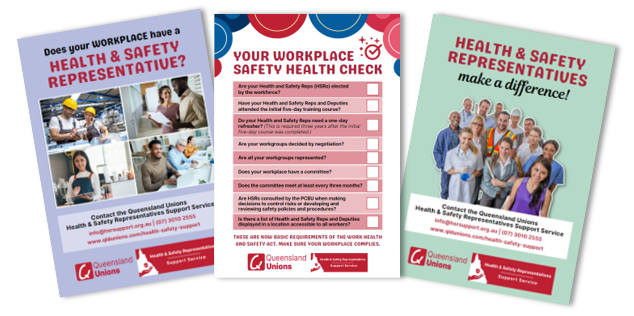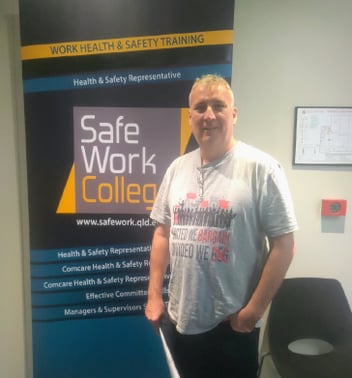HSR News June 2023 | Crossword challenge, healthy and safe workplaces
What is a safe and healthy workplace?
 A safe and healthy workplace is one where employees can perform their duties without exposure to risks that could lead to injury, illness, or death.
A safe and healthy workplace is one where employees can perform their duties without exposure to risks that could lead to injury, illness, or death.
In a healthy, safe, and thriving workplace, people feel good about working and can perform at their best.
Workplace health and safety refers to the right of every employee, regardless of industry, to carry out their daily work in a safe environment.
The work health and safety legislative framework provides what employers must do to ensure their duty of care – to eliminate or minimise the risk of incidents, injuries, illnesses and fatalities, so far as is reasonably practicable.
WHAT IS A SAFE AND HEALTHY WORK ENVIRONMENT?
A safe and health work environment doesn’t just happen – it’s created by working together. A safe and health work environment is good for worker health, safety, and wellbeing.
While poor physical work environments can put workers at risk of physical and mental ill-health, your work environment is more than your physical surroundings. It includes the way that you do your work, the materials and equipment that you work with and the emotional and psychological demands on workers.
WHAT IS HEALTH SAFETY & WELLBEING?
Workplace health and wellbeing relates to all aspects of working life, from the quality and safety of the physical environment to how people feel about their work, the culture at work, the way work is organised and how people are encouraged to maintain good physical and mental health.
WHAT IS WORK HEALTH AND SAFETY (WHS)?
Work health and safety (WHS) involves managing risks to the health and safety of everyone in the workplace, this includes:
- Workers
- Customers
- Visitors
- Suppliers
Creating a safe work environment is a legal requirement. It is also critical to the long-term success of a business/workplace.
WHAT IS A SAFETY CULTURE?
A safety culture is an organisational/workplace culture that places a high level of importance on safety beliefs, values, and attitudes – and these are shared by the majority of people within the company or workplace. It can be characterised as “the way we do things around here”. A positive safety culture can result in improved workplace health and safety (WHS) and organisational performance.
Crossword Challenge
Test your WHS/HSR knowledge!
[Answers will be posted in next month’s newsletter]

Across
2 - Health and safety in the workplace is the responsibility of [blank]5 - It is not just a physical injury
6 - Immediate risk to your health and safety
8 - A cease work can be directed when there is an [blank] risk to the health and safety of workers
Down
1 - They can issue a PIN
3 - A safe and healthy work [blank] doesn’t just happen
4 - It is the likelihood of a hazard causing harm
7 - It has the potential to harm you
Laws and Compliance - did you know?
 Penalties
Penalties
If a PCBU does not fulfill their duties or obligations, they are in breach of the Work Health and Safety Act 2011 Work Health and Safety Act 2011 - Queensland Legislation - Queensland Government or the Electrical Safety Act 2002 Electrical Safety Act 2002 - Queensland Legislation - Queensland Government.
Breaches
A breach occurs when the law is not upheld, when:
- An action is taken that places a person at risk of injury, illness or death.
- Steps are not taken to avoid a risky situation from occurring.
- There is a failure to comply with regulatory requirements.
Examples of breaches of the Work Health and Safety Act:
- Exposing workers to the risk of excessive noise.
- Working at heights where the risk of falling is not controlled.
- Allowing unlicensed operators to use specified equipment such as forklifts.
- Not ensuring that plant is appropriately guarded to eliminate or minimise exposure of workers to moving parts.
- Failing to have in place safe work method statements for work carried out in or near a confined space.
- Not notifying the Office of Industrial Relations (OIR) when a notifiable serious injury or illness occurs at your workplace.
Electrical Safety Breaches – Examples of breaches of the ES Act include:
- Performing unlicensed electrical work.
- Carrying out electrical work on energised electrical equipment when not permitted.
- Allowing unlicensed operators to use specified equipment such as forklifts.
- Not testing electrical work to ensure it is electrically safe.
- Not notifying the OIR of a serous electrical incident (SEI) or dangerous electrical event (DEE).
Categories of offences
There are four categories of offences for failing to comply with a health and safety duty under the WHS Act and SRWA Act or an electrical safety duty under the ES Act, depending on the degree of seriousness or liability involved.
Industrial Manslaughter – is the highest penalty. Where a PCBU, or a senior officer, negligently causes the death of a worker.
Category 1 – is the next highest penalty. These are serious breaches where a duty holder who recklessly endangers a person to risk of death or serious injury.
Category 2 – Failure to comply with a health and safety duty or electrical safety duty that exposes a person to risk of death, serious injury or illness.
Category 3 – Failure to comply with a health and safety duty or electrical safety duty.
For more information on breaches and penalties visit Penalties | WorkSafe.qld.gov.au [Reference: WHSQ website]
HSR DISCUSSION GROUP
Have you joined our Facebook Group yet?
HSR Support Service provides HSRs across Queensland with advice, community and support through a private page designed just for you.
The page offers:
- Support in your role as an HSR
- Relevant WHS information
- Legislative updates
- The opportunity to network with other Health & Safety Representatives
- Answers to questions you may have about your role and WHS issues
If you are not yet a member of the group, click here to join.
Posters and flyers for your workplace!

HSR Support Service has posters and flyers you can use in your workplace. If you would like to access these, please email Kylie at kyliem@qcu.asn.au. They can be sent to you electronically or in hard copy.


